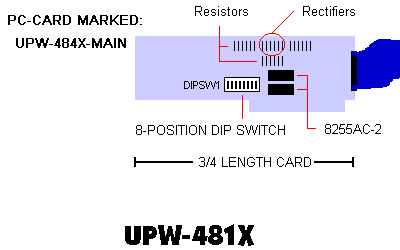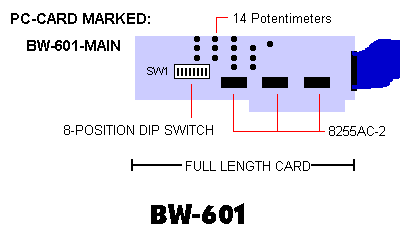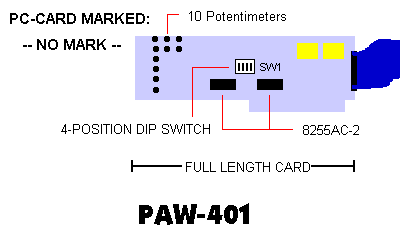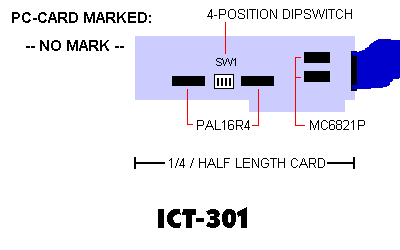
What programmer do you have?
Some programmers are badly marked or have no mark at all and some programmers don't have information about the I/O addresses for the dipswitch printed on the pc-card. You should be able to find out what programmer you have / how to configurate it from the informations below.
Eprom programmers
Here is the difference between some eprom programmers from Sunshine:
- If the ISA card is a FULL length card WITH a 8-position dipswitch then it is a EW-704 or a EW-708 programmer. The number EW-704X-MAIN (pc-card no. 03-078A 704) should be printed on the pc-card (at the bottom on the component side). Please notice that the EW-708 I have seen is marked like the EW-704
- If the ISA card is a HALF length card WITH a 8-position dipswitch then it is a EW-701 programmer. The pc-card should be marked: 03-109A 701
- If the ISA card is a HALF length card WITHOUT a dipswitch then it is a EW-904 card.
- If the ISA card is a HALF/ 3/4 length card WITH a 4-position dipswitch (SW1) and the socket-box have 10 sockets then it is a EW-910 eprom programmer. There is no mark on the pc-card.
- If the ISA card is a HALF/ 1/4 length card WITHOUT many components but
with 3 dipswitchs it is a SAC-101A interface card (SAC-101 should be
printed on the card) used with the HEP-800 serie High speed programmer.
EW-70x serie: PC-card with a lot of electronics and a flat-cable to
the textool-box. x=1,4 or 8 32-pin textools/test sockets. Programs 2716-27010, 28C16/17/64, 271000
You can test the PC-cards programming voltage with a multimeter by pressing x on your keyboard from the main menu.
8-position dipswitch:
| position | I/O address |
| 1 | 200h |
| 2 | 220h |
| 3 | 240h |
| 4 | 260h |
| 5 | 280h |
| 6 | 2A0h |
|---|
| 7 | 2C0h |
| 8 | 2E0h |
EW-90x serie: PC-card with a lot of electronics and a flat-cable to
the textool-box. x=1 or 4 28-pin textools/test sockets. Programs 2716-27C512
You can test the PC-cards programming voltage with a multimeter by pressing x on your keyboard from the main menu.
No dipswitch.
SUNSHINE EPROM PROGRAMMER CARD : EW-904BN(new model)
1.0 REVISION OF EW-904 series :
MODEL EW-904,904A: have been faded out at 1986,servicing only.
I/O BASE ADDRESS is 3C0.
Software V1.0 to V5.7 is old style menu.
Software V6.0 or greater is new style menu.
More powerful than old software.
MODEL EW-904B : have been faded out,servicing only.
I/O BASE ADDRESS is 390.
Software V1.0 to V5.7 is old style menu.
Software V6.0 or greater is new style menu.
More powerful than old software.
MODEL EW-904BN : available at end of FEB 1989(new model).
I/O BASE ADDRESS is 2A0.
Software V7.0 is almost the same as V6.0.
We add a built in screen editor that is more friendly
than DOS DEBUG.COM.
Because we apply some filter circuit on test socket
BOX and interface card, the CMOS EPROM problems
are solved on this model.
CMOS EPROM can be programmed by general NMOS EPROM
programming algo., except that the NS CMOS EPROM
has to be programmed by its own algo.
NOTE
EW-904BN is not compatible with EW-904B on software and hardware.
EW-910:PC-card with a lot of electronics and a flat-cable to
the textool-box. 10 28-pin textools/test sockets. Programs 2716-27C512
4-position dipswitch:
| I/O address / position | 4 | 3 | 2 | 1 |
|---|
| 200h | ON | ON | ON | ON |
| 210h | ON | ON | ON | OFF |
| 220h | ON | ON | OFF | ON |
| 230h | ON | ON | OFF | OFF |
| 240h | ON | OFF | ON | ON |
| 250h | ON | OFF | ON | OFF |
| 260h | ON | OFF | OFF | ON |
| 270h | ON | OFF | OFF | OFF |
| 280h | OFF | ON | ON | ON |
| 290h | OFF | ON | ON | OFF |
| 2A0h | OFF | ON | OFF | ON |
|---|
| 2B0h | OFF | ON | OFF | OFF |
| 2C0h | OFF | OFF | ON | ON |
| 2D0h | OFF | OFF | ON | OFF |
| 2E0h | OFF | OFF | OFF | ON |
| 2F0h | OFF | OFF | OFF | OFF |
This is taken from the manual. I think that the dipswitch on the pc-card is numbered in reverse order! (If you have worked a little with binary numbers I think you can see the point)
After selection on the pc-card you run the program PORTSEL.EXE for setting the I/O address in the software. Default address is 2A0h
Problems using the EW-900 serie:It can be a problem programming on a fast PC like the 486+ because the EW-900 serie is very critical about the AT-bus (ISA) speed which is running approx. 8MHz and if it is too high there can be a problem. The AT-bus speed have to run below 8MHz (or as slow as possible) but even that is not always enough. I don't know why, but sometimes it simply won't run!
If you have a 486 PC you could try to turn OFF the turbo speed and see if it helps before changing the BIOS.
You can change the AT-bus speed in the BIOS. If it is an AMI BIOS then you change the 'BUS CLOCK SELECTION: CLKIN/3' to 'CLKIN/5' or some high number to slow it down. If it is an AWARD BIOS then you have to change the '8-bit I/O Recovery Time'. Remember that it is only the speed of the ISA-bus that you have to change. If it doesn't solve your problem, then there is nothing else you can do than use a 386 or older machine to run the programmer. (I have never heard of problems on a 386)
HEP-80x serie: SAC-101 card with nearly no electronics and a round cable (standard D-25 parallel cable)
to the box with the textools (all the electronics is placed in the box). x=1,4 or 8 32-pin textools/test sockets. Programs 2716-27C080, 271000, 28C16-28C040, FLASH 28F256-28F020, 28F001BX-B/T
It CANNOT program 29Fxxx due to a hardware limit.
The I/O addresses is printet near to the 2 dipswitchs on the pc-card.
The 3. dipswitch is a 4-position dipswitch which control the waitstates. You can select 8, 4, 2 or 1 waitstates. Default is 4 waitstates. If you have problems using your programmer (no contact: "Error identification ...") you could try to change the waitstates. It could be a timing problem. I see no change if I use 8 waitstates or I use 1 waitstate so I always use default.
Old programmers
Here is some details about some old programmers from Sunshine (Have been faded out around 1991). The software is not necessary the latest software, but the only one I have:
UPW-481X:1 socket MPU (8748/49) programmer - programs 8748/48H/49H/50H/41A/41AH/42/42H
PC-CARD SHOULD BE MARKED: UPW-484X-MAIN. (3/4 length card).

8-position dipswitch:
| position | I/O address |
| 1 | 200h |
| 2 | 220h |
| 3 | 240h |
| 4 | 260h |
|---|
| 5 | 280h |
| 6 | 2A0h |
| 7 | 2C0h |
| 8 | 2E0h |
Software for UPW-481X
BW-601:1 socket Bipolar programmer - programs from 32x8 to 4096x8 as e.g.
63S080/280, 74S188/471/421, 82S23/135/321, 24S10, 7620
PC-CARD SHOULD BE MARKED: BW-601-MAIN. (Full length card).

8-position dipswitch:
| position | I/O address |
| 1 | 200h |
| 2 | 220h |
|---|
| 3 | 240h |
| 4 | 260h |
| 5 | 280h |
| 6 | 2A0h |
| 7 | 2C0h |
| 8 | 2E0h |
Software for BW-601
PAW-401:1 socket PAL programmer - programs 20-pins and 24-pins PAL as e.g. 10H8,12H6,16L2,16L8,12L10,14L8,20X10,20R4 ...
PC-CARD SHOULD NOT BE MARKED. (Full length card).

4-position dipswitch:
| I/O address / position | 4 | 3 | 2 | 1 |
|---|
| 200h | ON | ON | ON | ON |
| 210h | ON | ON | ON | OFF |
| 220h | ON | ON | OFF | ON |
| 230h | ON | ON | OFF | OFF |
| 240h | ON | OFF | ON | ON |
| 250h | ON | OFF | ON | OFF |
| 260h | ON | OFF | OFF | ON |
| 270h | ON | OFF | OFF | OFF |
| 280h | OFF | ON | ON | ON |
|---|
| 290h | OFF | ON | ON | OFF |
| 2A0h | OFF | ON | OFF | ON |
| 2B0h | OFF | ON | OFF | OFF |
| 2C0h | OFF | OFF | ON | ON |
| 2D0h | OFF | OFF | ON | OFF |
| 2E0h | OFF | OFF | OFF | ON |
| 2F0h | OFF | OFF | OFF | OFF |
This is taken from the manual. I think that the dipswitch on the pc-card is numbered in reverse order! (If you have worked a little with binary numbers I think you can see the point). According to the manual only address 280h to 2F0h can be selected but PORTSEL.EXE accept all the above addresses!
After selection on the pc-card you run the program PORTSEL.EXE for setting the I/O address in the software. Default address is 280h
Software for PAW-401
ICT-301:1 socket IC-tester / D-RAM tester - tests TTL 74/75, CMOS 40/45/140/145, D-RAM 4164,41256,4464,44256
PC-CARD SHOULD NOT BE MARKED. (1/4 / half length card).

4-position dipswitch:
| I/O address / position | 4 | 3 | 2 | 1 |
|---|
| 200h | ON | ON | ON | ON |
| 210h | ON | ON | ON | OFF |
| 220h | ON | ON | OFF | ON |
| 230h | ON | ON | OFF | OFF |
| 240h | ON | OFF | ON | ON |
| 250h | ON | OFF | ON | OFF |
| 260h | ON | OFF | OFF | ON |
| 270h | ON | OFF | OFF | OFF |
| 280h | OFF | ON | ON | ON |
| 290h | OFF | ON | ON | OFF |
|---|
| 2A0h | OFF | ON | OFF | ON |
| 2B0h | OFF | ON | OFF | OFF |
| 2C0h | OFF | OFF | ON | ON |
| 2D0h | OFF | OFF | ON | OFF |
| 2E0h | OFF | OFF | OFF | ON |
| 2F0h | OFF | OFF | OFF | OFF |
This is taken from the manual. I think that the dipswitch on the pc-card is numbered in reverse order! (If you have worked a little with binary numbers I think you can see the point). According to the manual only address 280h to 2F0h can be selected but PORTSEL.EXE accept all the above addresses!
After selection on the pc-card you run the program PORTSEL.EXE for setting the I/O address in the software. Default address is 290h
Software for ICT-301
 Tilbage til Sunshine informationsmenu
Tilbage til Sunshine informationsmenu






 Tilbage til Sunshine informationsmenu
Tilbage til Sunshine informationsmenu